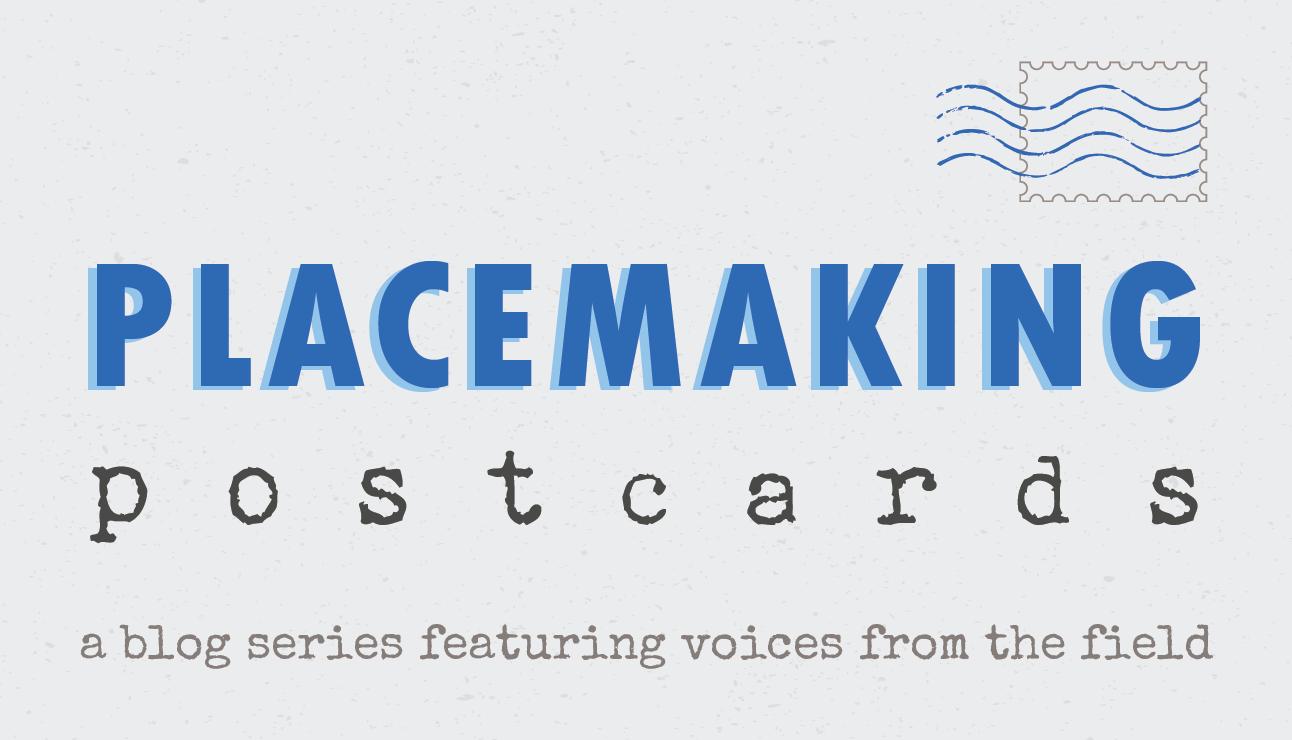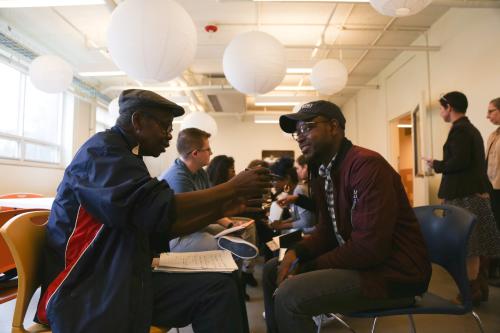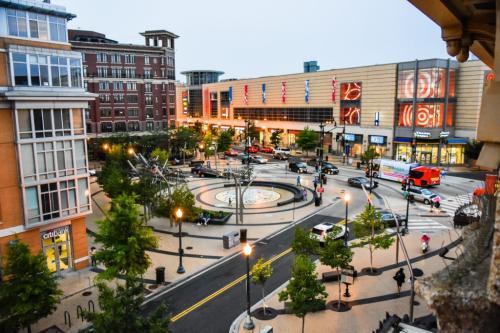Placemaking Postcards is a blog series from the Bass Center for Transformative Placemaking at Brookings where policymakers and practitioners guest-author promising placemaking efforts from across the U.S. and abroad that foster connected, vibrant, and inclusive communities. In line with the principle tenets of placemaking, the goal of the series is to recognize the community as the expert, highlight voices from the field, and to create a community of learning and practice around transformative placemaking.
At the corner of North and Cecil Avenues in Central Baltimore sits the newly constructed home of a community-based organization, Roberta’s House, which provides mental health and grief counseling services to residents who may not otherwise get these much-needed services. The building represents a transformational investment designed to bring new life to a vacant block that was previously occupied by rowhomes.
When construction on Roberta’s House broke ground in 2018, the two sides of Cecil Avenue at this corner were divided, both physically and symbolically. The juxtaposition of abandoned rowhomes on one side and hope rising from the ground on the other side, sparked a thought among staff at Baltimore’s Weinberg Foundation: What if this building were to be the start of a ripple of redevelopment and opportunity in the neighborhood?
And so, the revitalization of this one building on this one corner would soon become part of something bigger—a philanthropic-funded effort to improve the health and life trajectory of Central Baltimore residents. This piece tells the story of lessons from the Greenmount Life, Opportunity, and Wellness (GLOW) Initiative, a new effort to concentrate financial and social investment in select neighborhoods that have long experienced underinvestment.
Developing a hyper-local strategy rooted in strength
Created in 1990, The Harry and Jeanette Weinberg Foundation had been funding Baltimore-based nonprofits for 30 years when, beginning in 2018 and following many conversations with stakeholders, the foundation adopted a hyperlocal, place-based strategy (while continuing to provide grants across the Baltimore region). The premise was that by focusing some of the foundation’s financial and social capital in a compact geographic area, it could drive positive outcomes in an even more targeted way. Out of this decision came GLOW.
We knew that one of the most important factors in getting GLOW off the ground was choosing the right area on which to focus our efforts. Several factors led to our selection of four Central Baltimore neighborhoods, Midway, Barclay, Harwood, and Greenmount West, including:
- Need: Many residents of our target neighborhoods had limited economic opportunity and poor health. Midway, for example, had the highest unemployment rate of any neighborhood in the city, the sixth lowest life expectancy, and one of the city’s highest concentrations of children living in poverty.
- Concurrent investment: While Baltimore City, despite decades of disinvestment, had designated the area as one of its “Impact Investment Areas,” other major developments, including a large nonprofit makerspace, were already underway or forthcoming in the area. Meanwhile, a coalition of funders had also recently launched the Central Baltimore Future Fund to catalyze commercial redevelopment. We recognized that GLOW would be more successful if it aligned with those efforts.
- Partners: The area also is home to four public schools and many nonprofits, including Central Baltimore Partnership (CBP), a nonprofit collaborative of over 100 organizations dedicated to the revitalization of Central Baltimore neighborhoods. These partners already had meaningful relationships and capacity that if brought together could help achieve more positive outcomes for the neighborhoods around GLOW’s goals.
With all of this in mind, Weinberg Foundation saw an opportunity to improve Central Baltimore’s economic and public health outcomes by working with CBP to physically transform the four neighborhoods, while placing special emphasis on health and educational outcomes for their residents. In this way, the Foundation was able to tap into existing organizational infrastructure—essentially building from strength instead of building from scratch.
Strong and glowing: From an idea to implementation
The central purpose of GLOW is to mobilize and coordinate an array of organizations to improve the health and life trajectory of Central Baltimore residents by improving access to, and utilization of, primary health care, nutritious food, and enriching educational or career opportunities for youth. While the long-term goal is to make an impact on key indicators like unemployment and life expectancy, we know that those will take years. In the interim, we are squarely focused on supporting the initiative as a platform for aligning multiple organizations, sourcing and advancing residents’ goals and desire, lifting up residents as leaders, and attracting additional resources to the neighborhood.
We’ve had some early wins. For example, GLOW has established a network of more than 30 service providers, including a national organization it recruited to the neighborhood, which will connect 125 families with housing, employment, financial, and supportive services that help increase economic mobility. Other wins include expanding paid summer youth opportunities in the neighborhood by partnering with Banner Neighborhoods to operate a YouthWorks site, and catalyzing the development of several key capital projects including an outdoor education and community health hub along with a teaching kitchen. Along the way, we’ve also learned a lot of lessons relevant for any equity-focused place-based initiative, including:
- The lead organization for a place-based initiative—CBP in the case of GLOW—must be adept at navigating a range of efforts and stakeholders. Specifically, it must be capable of both strategic and tactical efforts and have trust and relationships with a range of stakeholders, including funders, government leaders, and residents. The organization must focus on strategy at all levels and not get bogged down in the day-to-day of providing services and activities in the neighborhood.
- Genuine partnership means more than ‘partners on paper’. Partnership, like collaboration, is a term that gets used a lot and can mean different things to different people. With GLOW, we have found that true partnership requires more than regular meetings or information sharing. It demands building trusting relationships rooted in an “if you win, I win” mentality instead of in the scarcity mindset that often pervades the nonprofit sector, especially when it comes to working with foundations. It means jointly applying for funding, being clear about expectations and roles, and navigating conflict.
- Community leadership is as important as community engagement. For place-based initiatives like GLOW, it’s critical that residents not just be engaged in typical ways like surveys or public meetings. Instead, residents should have genuine leadership and decision-making authority— meaning equal or greater representation on the committee overseeing the initiative, with compensation for their time and insights.
- Planning takes time and resources. Place-based initiatives require coordinating across city agencies, nonprofit organizations, and resident leaders—as well as including visible wins in early months to build trust and buy-in with residents and partners. This took us two years and required flexibility as the COVID-19 pandemic extended timelines and shifted our attention. Even under normal circumstances planning requires significant staff time to thoughtfully engage residents and stakeholders in small group and one-on-one conversations.
- Patience is essential. Place-based initiatives require a long-term commitment due to the nature of developing the infrastructure across sectors to create systemic, long-term change. Phases include understanding the challenges and opportunities in the community, building the infrastructure across multiple partners, and capacity building for anchor institutions—all before achieving neighborhood-level outcomes.
With these lessons in mind, we are continuing to invest in and build GLOW so it can serve as a platform for convening resident and stakeholders to drive change in Central Baltimore for many years to come. By focusing on strategy, building true partnerships, centering residents as leaders, investing in planning, and operating with a sense of flexibility and patience, we believe other funders and community-based organizations can build similar initiatives to help transform underinvested neighborhoods.
Photo credit: Ed Weiss
The Brookings Institution is committed to quality, independence, and impact.
We are supported by a diverse array of funders. In line with our values and policies, each Brookings publication represents the sole views of its author(s).









Commentary
How a neighborhood-focused Baltimore initiative is employing patience, partnership, and resident leadership to drive long-term change
June 7, 2023